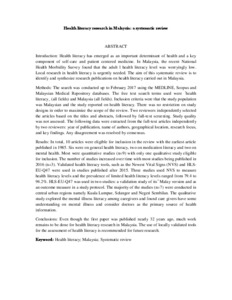Citation
Abdullah, Adina and Salim, Hani Syahida and Ng, Chirk Jenn and Liew, Su May
(2017)
Health literacy research in Malaysia: a systematic review.
In: 5th AHLA International Health Literacy Conference, 12-14 Nov. 2017, Kuala Lumpur, Malaysia. (p. 51).
Abstract
Introduction: Health literacy has emerged as an important determinant of health and a key component of self-care and patient centered medicine. In Malaysia, the recent National Health Morbidity Survey found that the adult l health literacy level was worryingly low. Local research in health literacy is urgently needed. The aim of this systematic review is to identify and synthesize research publications on health literacy carried out in Malaysia.
Methods: The search was conducted up to February 2017 using the MEDLINE, Scopus and Malaysian Medical Repository databases. The free text search terms used were “health literacy” (all fields) and Malaysia (all fields). Inclusion criteria were that the study population was Malaysian and the study reported on health literacy. There was no restriction on study designs in order to maximize the scope of the review. Two reviewers independently selected the articles based on the titles and abstracts, followed by full-text screening. Study quality was not assessed. The following data were extracted from the full-text articles independently by two reviewers: year of publication, name of authors, geographical location, research focus, and key findings. Any disagreement was resolved by consensus.
Results: In total, 10 articles were eligible for inclusion in the review with the earliest article published in 1985. Six were on general health literacy, two on medication literacy and two on mental health. Most were quantitative studies (n=9) with only one qualitative study eligible for inclusion. The number of studies increased over time with most studies being published in 2016 (n=3). Validated health literacy tools, such as the Newest Vital Signs (NVS) and HLS-EU-Q47 were used in studies published after 2015. Three studies used NVS to measure health literacy levels and the prevalence of limited health literacy levels ranged from 79.4 to 94.2%. HLS-EU-Q47 was used in two studies: a validation study of its’ Malay version and as an outcome measure in a study protocol. The majority of the studies (n=7) were conducted in central urban regions namely Kuala Lumpur, Selangor and Negeri Sembilan. The qualitative study explored the mental illness literacy among caregivers and found care givers have some understanding on mental illness and consider doctors as the primary source of health information.
Conclusions: Even though the first paper was published nearly 32 years ago, much work remains to be done for health literacy research in Malaysia. The use of locally validated tools for the assessment of health literacy is recommended for future research.
Download File
![[img]](http://psasir.upm.edu.my/71517/1.hassmallThumbnailVersion/Health%20literacy%20research%20in%20Malaysia%20a%20systematic%20review.pdf)  Preview |
|
Text (Abstract)
Health literacy research in Malaysia a systematic review.pdf
Download (50kB)
| Preview
|
|
Additional Metadata
Actions (login required)
 |
View Item |

